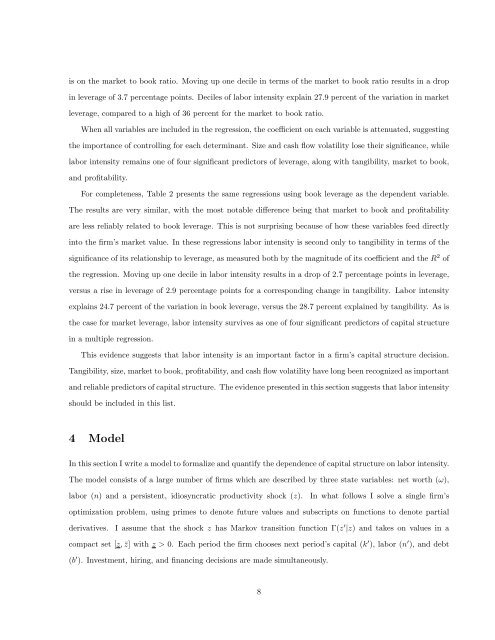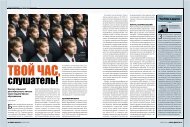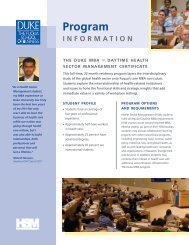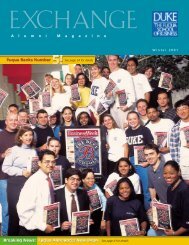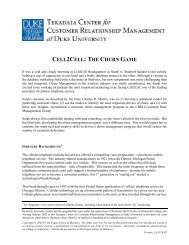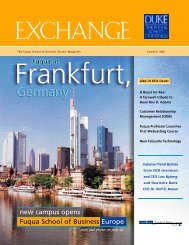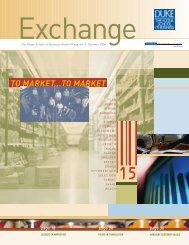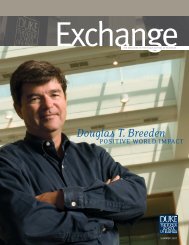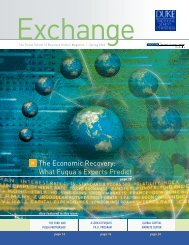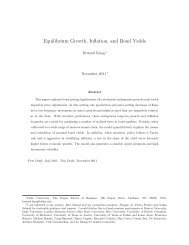A Structural Model of Human Capital and Leverage - Duke ...
A Structural Model of Human Capital and Leverage - Duke ...
A Structural Model of Human Capital and Leverage - Duke ...
You also want an ePaper? Increase the reach of your titles
YUMPU automatically turns print PDFs into web optimized ePapers that Google loves.
is on the market to book ratio. Moving up one decile in terms <strong>of</strong> the market to book ratio results in a drop<br />
in leverage <strong>of</strong> 3.7 percentage points. Deciles <strong>of</strong> labor intensity explain 27.9 percent <strong>of</strong> the variation in market<br />
leverage, compared to a high <strong>of</strong> 36 percent for the market to book ratio.<br />
When all variables are included in the regression, the coefficient on each variable is attenuated, suggesting<br />
the importance <strong>of</strong> controlling for each determinant. Size <strong>and</strong> cash flow volatility lose their significance, while<br />
labor intensity remains one <strong>of</strong> four significant predictors <strong>of</strong> leverage, along with tangibility, market to book,<br />
<strong>and</strong> pr<strong>of</strong>itability.<br />
For completeness, Table 2 presents the same regressions using book leverage as the dependent variable.<br />
The results are very similar, with the most notable difference being that market to book <strong>and</strong> pr<strong>of</strong>itability<br />
are less reliably related to book leverage. This is not surprising because <strong>of</strong> how these variables feed directly<br />
into the firm’s market value. In these regressions labor intensity is second only to tangibility in terms <strong>of</strong> the<br />
significance <strong>of</strong> its relationship to leverage, as measured both by the magnitude <strong>of</strong> its coefficient <strong>and</strong> the R 2 <strong>of</strong><br />
the regression. Moving up one decile in labor intensity results in a drop <strong>of</strong> 2.7 percentage points in leverage,<br />
versus a rise in leverage <strong>of</strong> 2.9 percentage points for a corresponding change in tangibility. Labor intensity<br />
explains 24.7 percent <strong>of</strong> the variation in book leverage, versus the 28.7 percent explained by tangibility. As is<br />
the case for market leverage, labor intensity survives as one <strong>of</strong> four significant predictors <strong>of</strong> capital structure<br />
in a multiple regression.<br />
This evidence suggests that labor intensity is an important factor in a firm’s capital structure decision.<br />
Tangibility, size, market to book, pr<strong>of</strong>itability, <strong>and</strong> cash flow volatility have long been recognized as important<br />
<strong>and</strong> reliable predictors <strong>of</strong> capital structure. The evidence presented in this section suggests that labor intensity<br />
should be included in this list.<br />
4 <strong>Model</strong><br />
In this section I write a model to formalize <strong>and</strong> quantify the dependence <strong>of</strong> capital structure on labor intensity.<br />
The model consists <strong>of</strong> a large number <strong>of</strong> firms which are described by three state variables: net worth (ω),<br />
labor (n) <strong>and</strong> a persistent, idiosyncratic productivity shock (z). In what follows I solve a single firm’s<br />
optimization problem, using primes to denote future values <strong>and</strong> subscripts on functions to denote partial<br />
derivatives. I assume that the shock z has Markov transition function Γ(z ′ |z) <strong>and</strong> takes on values in a<br />
compact set [z, ¯z] with z > 0. Each period the firm chooses next period’s capital (k ′ ), labor (n ′ ), <strong>and</strong> debt<br />
(b ′ ). Investment, hiring, <strong>and</strong> financing decisions are made simultaneously.<br />
8


